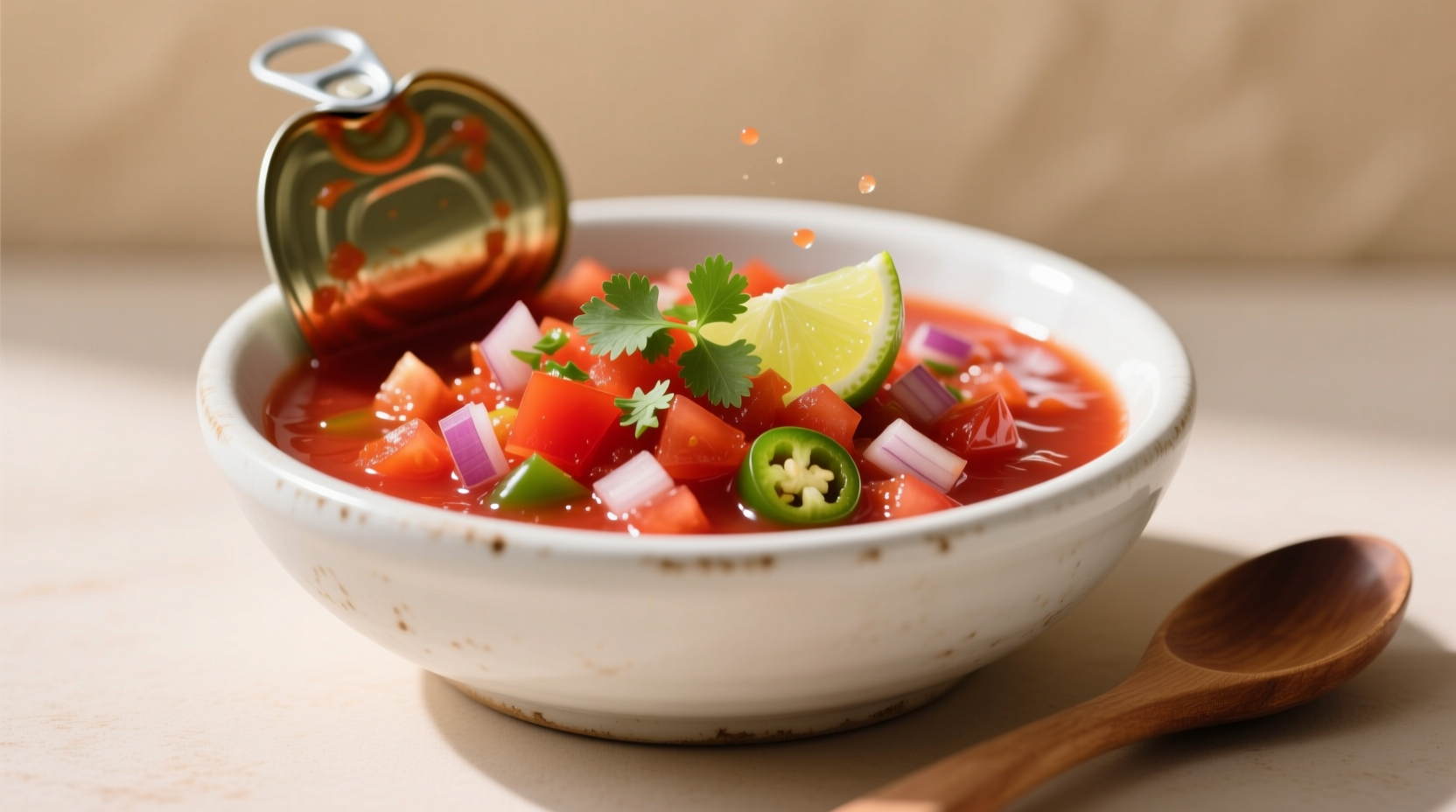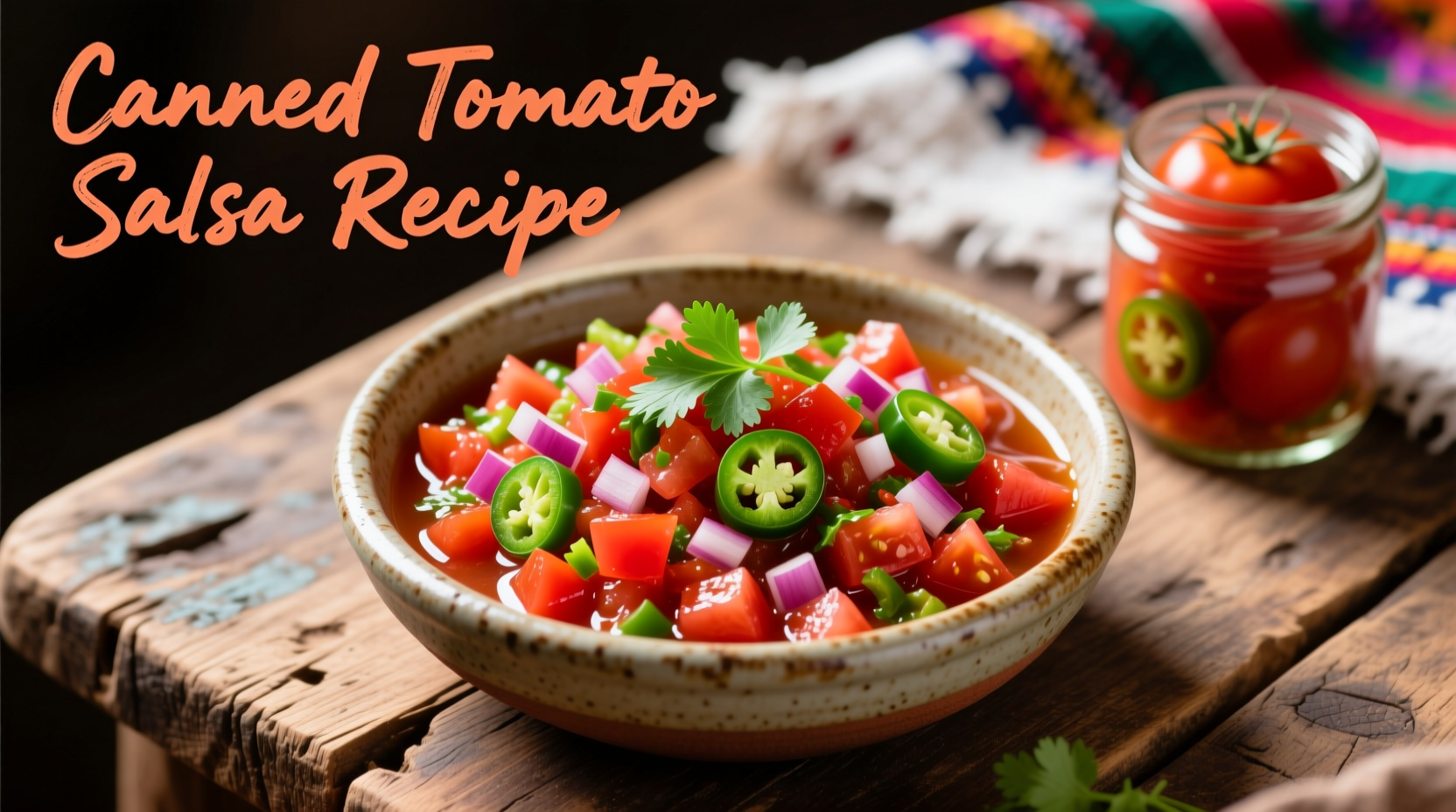Here's a quick, pantry-friendly canned tomato salsa recipe that delivers fresh flavor in just 15 minutes: drain one 14.5-ounce can of fire-roasted diced tomatoes, mix with 1/2 cup finely diced red onion, 1 minced jalapeño, 1/4 cup chopped cilantro, 2 tablespoons lime juice, 1 teaspoon cumin, and salt to taste. Let rest for 30 minutes before serving for optimal flavor development.
When fresh tomatoes aren't in season or you need a quick solution, canned tomatoes make an unexpectedly excellent salsa base. Contrary to popular belief, quality canned tomatoes often contain more consistent flavor than off-season fresh tomatoes, especially during winter months when vine-ripened options are scarce. This recipe solves the common problem of "I want fresh salsa but don't have access to good tomatoes" with ingredients you likely already have in your pantry.
Why Canned Tomatoes Work Better Than You Think
Many home cooks hesitate to use canned tomatoes for salsa, assuming fresh is always superior. However, food science reveals an interesting truth: canned tomatoes often have higher lycopene content due to the heat-processing method, which breaks down cell walls and makes this antioxidant more bioavailable. According to the USDA Food Data Central, fire-roasted canned tomatoes contain approximately 25% more lycopene than raw fresh tomatoes.
| Nutrient Comparison | Canned Tomatoes (per 100g) | Fresh Tomatoes (per 100g) |
|---|---|---|
| Lycopene | 12.3 mg | 8.7 mg |
| Vitamin C | 15 mg | 13 mg |
| Natural Sugars | 3.2 g | 2.6 g |
| Acidity (pH) | 4.3 | 4.7 |
This nutritional advantage, combined with consistent year-round availability, makes canned tomatoes a smart choice for reliable salsa preparation. The slightly higher acidity (lower pH) of canned tomatoes also contributes to better preservation when storing your finished salsa.
Essential Ingredients for Perfect Canned Tomato Salsa
The magic happens when you select quality components. For the best results:
- Canned tomatoes: Choose fire-roasted diced tomatoes without added calcium chloride (which can make tomatoes mushy). Hunt's and Muir Glen offer excellent options.
- Onion: Red onion provides the ideal balance of sharpness and color without overwhelming the tomato flavor.
- Chilies: Fresh jalapeño (seeds removed for milder salsa) delivers authentic heat that canned chilies can't match.
- Acid component: Fresh lime juice is non-negotiable—bottled juice lacks the bright, complex acidity needed.
- Herb: Cilantro adds the distinctive fresh note that defines authentic salsa.

Step-by-Step Preparation Guide
Follow this professional technique for restaurant-quality results:
- Drain tomatoes properly: Place canned tomatoes in a fine-mesh strainer over a bowl. Gently press out excess liquid but reserve 2 tablespoons of the tomato juice for flavor balance.
- Prepare aromatics: Finely dice 1/2 cup red onion and mince 1-2 jalapeños (depending on heat preference), removing seeds and membranes for milder salsa.
- Combine ingredients: In a medium bowl, mix drained tomatoes, onion, jalapeño, 1/4 cup chopped cilantro, 2 tablespoons lime juice, 1 teaspoon ground cumin, 2 tablespoons reserved tomato juice, and salt to taste.
- Rest for flavor development: Cover and refrigerate for at least 30 minutes (up to 2 hours) before serving. This crucial step allows flavors to meld properly.
Customization Options for Different Preferences
Once you've mastered the basic recipe, experiment with these authentic variations:
- Smoky version: Add 1/4 teaspoon chipotle powder or 1 tablespoon minced canned chipotle in adobo sauce
- Fruit-infused: Mix in 1/2 cup diced mango or pineapple for a sweet contrast
- Restaurant-style: Blend half the mixture for 5 seconds for that familiar smooth-but-chunky texture
- Extra-herby: Add 2 tablespoons fresh oregano or epazote for traditional complexity
Storage Guidelines You Can Trust
Proper storage ensures both safety and quality. According to the FDA Food Code, salsa made with canned tomatoes (which have higher acidity) can be safely stored in the refrigerator for up to 7 days when kept at 40°F or below. For longer storage:
- Use glass containers with tight-fitting lids
- Leave 1/2 inch headspace to allow for expansion
- Freeze for up to 3 months (thaw in refrigerator)
- Never store at room temperature for more than 2 hours
Important food safety note: The USDA's Food Safety and Inspection Service emphasizes that homemade salsa should maintain a pH below 4.6 to prevent bacterial growth. The natural acidity of canned tomatoes (typically pH 4.3) combined with lime juice creates a safe environment when properly stored.
Troubleshooting Common Issues
Even simple recipes can encounter problems. Here's how to fix them:
- Too watery: Drain tomatoes more thoroughly or add 1-2 tablespoons tomato paste to thicken
- Not enough flavor: Let sit longer (up to 2 hours) or add a pinch of sugar to balance acidity
- Too acidic: Stir in 1/4 teaspoon honey or maple syrup to counterbalance
- Flat taste: Add a dash of Worcestershire sauce or 1/8 teaspoon smoked salt for depth
Why This Method Works Better Than Traditional Recipes
Traditional salsa recipes often rely on fresh tomatoes at their seasonal peak, creating inconsistency throughout the year. This canned tomato approach provides reliable results regardless of season. The canning process actually enhances certain flavor compounds through thermal processing—a phenomenon documented in food science research on the Maillard reaction in tomatoes.
Historically, salsa preparation evolved significantly after the introduction of canning technology in the 19th century. While fresh salsa has ancient Mesoamerican roots, the modern concept of shelf-stable tomato products enabled consistent salsa preparation year-round, particularly benefiting regions without ideal tomato-growing climates.











 浙公网安备
33010002000092号
浙公网安备
33010002000092号 浙B2-20120091-4
浙B2-20120091-4